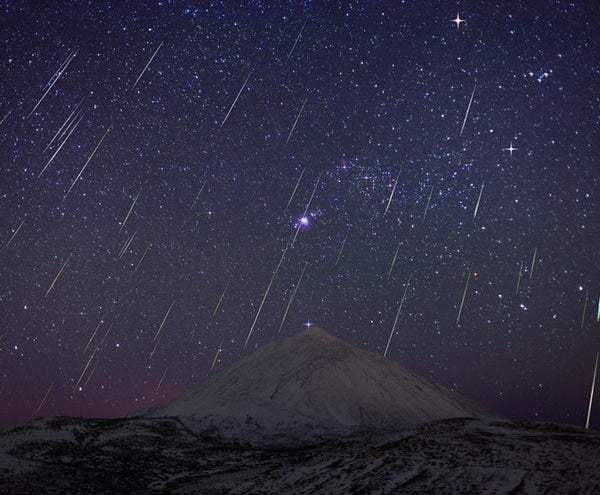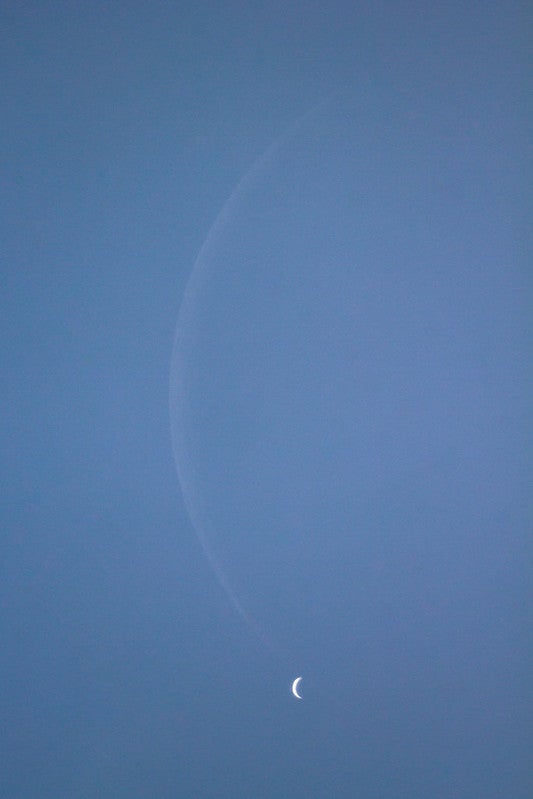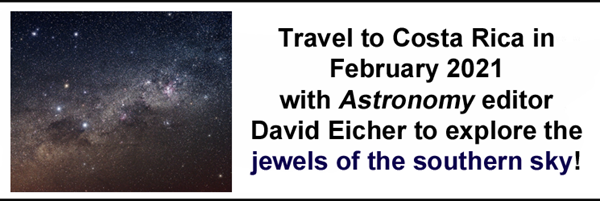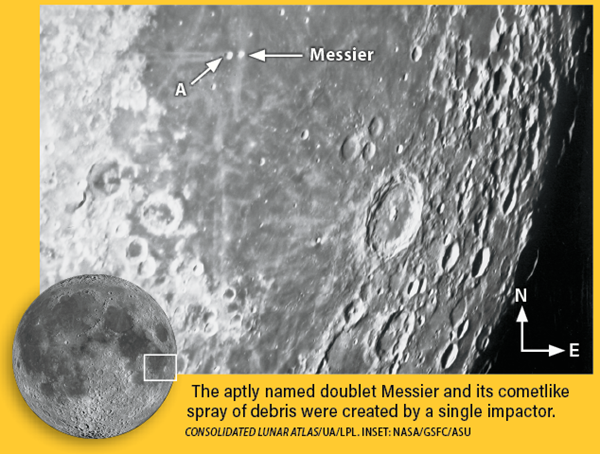Tonight there’s a two-for-one deal on galaxies when you look above the cup of the Big Dipper for M81 and M82, also known as Bode’s Galaxy and the Cigar Galaxy, respectively. These two spirals are part of the M81 group of galaxies, which contains at least 30 other galaxies in the constellations Ursa Major and nearby Camelopardalis. Astronomers believe M81 and M82 made a close pass several million years ago, which sparked activity in the central supermassive black hole in both. In M82’s case, the gravitational tango also kicked off intense bursts of star formation throughout the galaxy as well.
To find M81 and M82, use Dubhe, the bright star at the upper righthand corner of the Big Dipper’s cup, as a jumping-off point. Scan about 10.5° north-northwest of Dubhe using low power to catch them in the same field of view. M81 is magnitude 6.9, while M82 is a fainter 8.4. While they’re both spirals, M81 is tilted much less with respect to our field of view, meaning it appears more face on and more of its disk and spiral arms are visible. By contrast, M82 earns its nickname “the Cigar” thanks to its long, skinny appearance, which results from our more edge-on view.
The pair will rise higher in the sky with time as the circumpolar constellations rotate around Polaris, the North star.
Sunrise*: 7:12 A.M.
Sunset: 4:35 P.M.
Moonrise: 3:25 A.M.
Moonset: 2:33 P.M.
Moon Phase: Waning crescent (12%)
*Times for sunrise, sunset, moonrise, and moonset are given in local time from 40° N 90° W. The Moon’s illumination is given at 12 P.M. local time from the same location.
There’s a beautiful sight on display for early risers: A delicate 5-percent-lit Moon hangs about 4° above the planet Venus in the predawn sky. Both sit squarely in the constellation Libra, rising in the east. The Moon rises first, around 4:40 A.M.; Venus becomes visible about 30 minutes later. As sunrise comes and goes, our satellite will draw ever closer to the bright planet, which currently spans 11″ and is 91 percent lit.
Later today, from locations in the western U.S., Alaska, and Hawaii, the Moon will occult, or pass in front of, Venus in the daytime sky. By tomorrow morning, the Moon will appear to hang below the planet in the morning sky.
The Moon reaches perigee, the closest point to Earth in its orbit, at 3:42 P.M. EST today. At that time, it will sit 224,795 miles (361,772 kilometers) from our planet.
Sunrise: 7:13 A.M.
Sunset: 4:35 P.M.
Moonrise: 4:40 A.M.
Moonset: 3:10 P.M.
Moon Phase: Waning crescent (5%)
Sunday, December 13
Tonight is the night many observers have been waiting for — the peak of the Geminid meteor shower. The year’s best meteor shower officially reaches its maximum, with a rate of 150 meteors per hour, at 7 P.M. EST, making it ideal for families with children and those with Monday morning commitments. With no Moon in the sky, it’s an ideal opportunity to spot faint meteors as well as brighter ones.
Look for the radiant rising about two hours after sunset, when the constellation Gemini the Twins has cleared the horizon. The radiant sits just northwest of (above) the bright star Castor, the head of one twin. His brother’s head, Pollux, sits just 4.5° to the southeast.
Geminids are relatively slow-moving meteors known for their long, yellow-tinged trains. For the best chance of seeing these trains, cast your eyes about 30° to 60° away from the radiant. The Geminids will continue to put on an amazing show throughout the night and into the morning of the 14th, with the radiant reaching a point overhead for most North American observers around 1 A.M. on the 14th.
Sunrise: 7:14 A.M.
Sunset: 4:35 P.M.
Moonrise: 5:58 A.M.
Moonset: 3:52 P.M.
Moon Phase: Waning crescent (1%)
And if weather or other factors keep you from stepping outside to watch the show, the Instituto de Astrofísica de Canarias will be broadcasting the Geminids from the Canary Islands, starting at 5:30 PM EST. Check out the livestream below:
Monday, December 14
New Moon occurs today at 11:17 A.M. EST — and with it comes the last total solar eclipse of the year, visible from Chile and Argentina.
The total path length of this eclipse is 9,239 miles (14,869 km), but only 5 percent of this path falls on land. Fortunately, that 5 percent is where the eclipse’s longest duration of 2 minutes 10 seconds occurs, near Sierra Colorada, Argentina, at 4:13 P.M. UT.
Total solar eclipses occur when the Moon passes between Earth and the Sun, blocking our star from view and allowing us to see its tenuous outer atmosphere, the corona. But another condition must be met — the Moon must be the right distance away from Earth in its orbit to completely cover the Sun. Because the Moon’s orbit is slightly elliptical, if it is too far from Earth when it passes between us and our star, it doesn’t appear large enough to completely block the Sun. When this happens, we see an annular solar eclipse, during which an outer ring of the Sun’s surface remains visible.
Sunrise: 7:15 A.M.
Sunset: 4:35 P.M.
Moonrise: 7:13 A.M.
Moonset: 4:42 P.M.
Moon Phase: New
The constellation Perseus the Hero is high in the sky several hours after sunset. He’s home to the famous Double Cluster, comprising NGC 869 and NGC 884 (also called H and Chi [χ] Persei). From a dark location — and with no Moon, like tonight — you may be able to spot them with the naked eye. In fact, early observers first cataloged this pair around 130 B.C.
Start your search at Perseus’ alpha star, Mirfak, which glows at magnitude 1.8. Look north-northwest of Mirfak to find magnitude 2.9 Gamma (γ) Persei, then north-northwest again to find magnitude 3.8 Eta (η) Persei. The Double Cluster sits about 4° northwest of this star and will likely appear as one or two fuzzy patches to your unaided eye.
Binoculars or a telescope will bring out these open clusters’ myriad stars. Each contains several hundred young suns some few million to 10 million years old — extremely young by stellar standards.
Sunrise: 7:15 A.M.
Sunset: 4:36 P.M.
Moonrise: 8:22 A.M.
Moonset: 5:41 P.M.
Moon Phase: Waxing crescent (2%)
Wednesday, December 16
Look southwest after sunset for a triple treat tonight: The thin crescent Moon lies less than 6° southwest of bright Jupiter and Saturn. Our satellite shares the constellation Sagittarius with the solar system’s largest planet, while Saturn stands just over the invisible border in Capricornus. Look first at the Moon to see if you can spot the earthshine effect — sunlight reflecting off Earth and illuminating the portion of the Moon still in shadow.
The Moon also provides a perfect tool for comparison. Tonight, the ringed planet (magnitude 0.6) is just 0.5° from Jupiter (magnitude –2) — that’s the width of the Full Moon in the sky. But they’re going to get even closer. On the night of the winter solstice next week, the pair will form a nearly indistinguishable “star” in the sky as they come within 0.1° of each other. In a low-power binocular or telescope field, you’ll be able to see both in a single view. This is a sight you won’t want to miss, so begin planning your observations now.
Later tonight, the Moon will pass 3° south of Jupiter at 11 P.M. EST. Our satellite will then pass 3° south of Saturn at midnight EST.
Sunrise: 7:16 A.M.
Sunset: 4:36 P.M.
Moonrise: 9:22 A.M.
Moonset: 6:45 P.M.
Moon Phase: Waxing crescent (6%)
and we’ve got everything you need to know about
how to view the upcoming Great Conjunction.
Thursday, December 17
Bright Vega in Lyra is hard to miss in the evening sky, blazing in the northwest after sunset. Although this magnitude 0 luminary far outshines the other stars in its constellation, there are many more reasons to explore the rest of the Harp.
One is Sheliak (Beta [β] Lyrae), a multiple-star system that sits 6° south-southeast of Vega. Through binoculars or a small scope, you can easily resolve a magnitude 3.6 primary and a magnitude 6.7 secondary separated by 45″. Furthermore, the brighter star, Beta A, is an eclipsing binary (think Algol in Perseus), swinging between magnitude 3.3 and 4.3 in a little less than 13 days as its companion passes in front of and behind it. At maximum, Beta is closest in brightness to nearby Gamma (γ) Lyrae, about 2° to its east. At minimum, it better matches Zeta (ζ) Lyrae, 4.5° north.
Zeta is also a multiple-star system, comprising as many as seven stars. Through binoculars, you can easily separate Zeta A and B — A is the brightest at magnitude 4.3, while B is a dimmer magnitude 5.6 and sits 44″ away from its companion.
Sunrise: 7:17 A.M.
Sunset: 4:36 P.M.
Moonrise: 10:11 A.M.
Moonset: 7:52 P.M.
Moon Phase: Waxing crescent (12%)
Zoom in on the Moon today for a look at an interesting crater doublet: Messier and Messier A. You’ll find our satellite low in the south at sunset, but there are a few hours of darkness to observe before it sinks below the horizon around 9 P.M. local time.
Look with a telescope toward the Moon’s eastern limb, along its equator. There you’ll find the large crater Langrenus, with its distinctive central peaks. To the northwest of this crater is a small pair of impacts; the westernmost pockmark has a distinctive cometlike trail of debris spreading farther west. These are Messier and Messier A, named for the famous 18th-century comet hunter Charles Messier. The pair’s strange appearance is attributed to a single impact that struck the Moon at a low angle and essentially skipped once along the surface.
Bump your magnification up to 100x and you’ll see the Messier doublet is distinctly out of round when compared with its fellow craters. Come back over the next few nights for even better views of its one-way rays, as the changing Sun angle brings them into even better contrast.
Sunrise: 7:17 A.M.
Sunset: 4:37 P.M.
Moonrise: 10:51 A.M.
Moonset: 8:59 P.M.
Moon Phase: Waxing crescent (20%)













